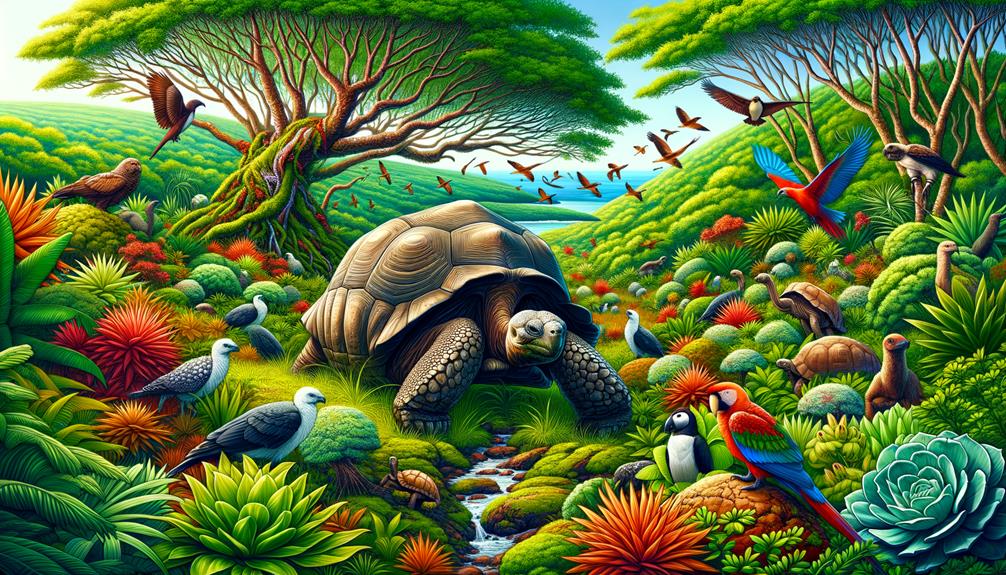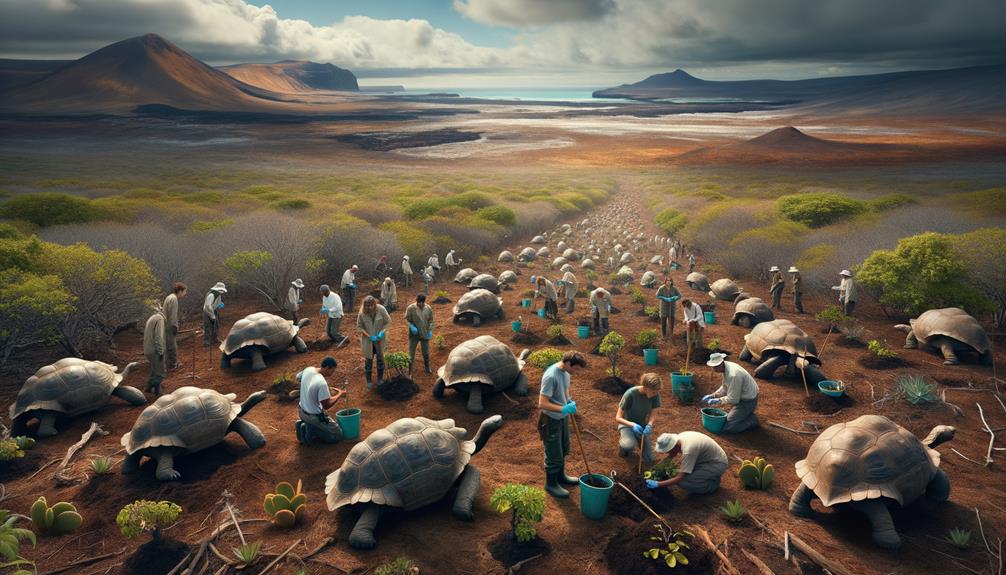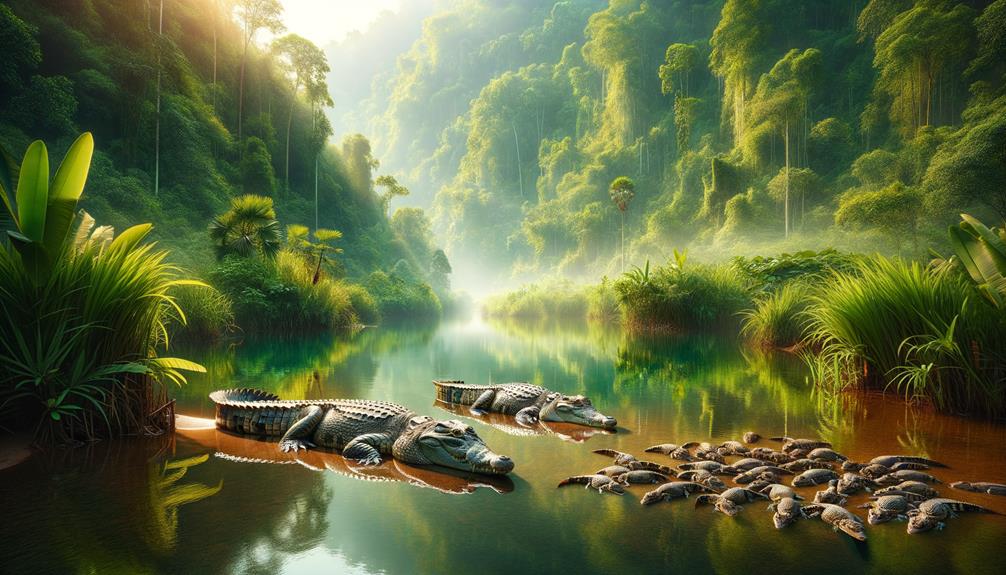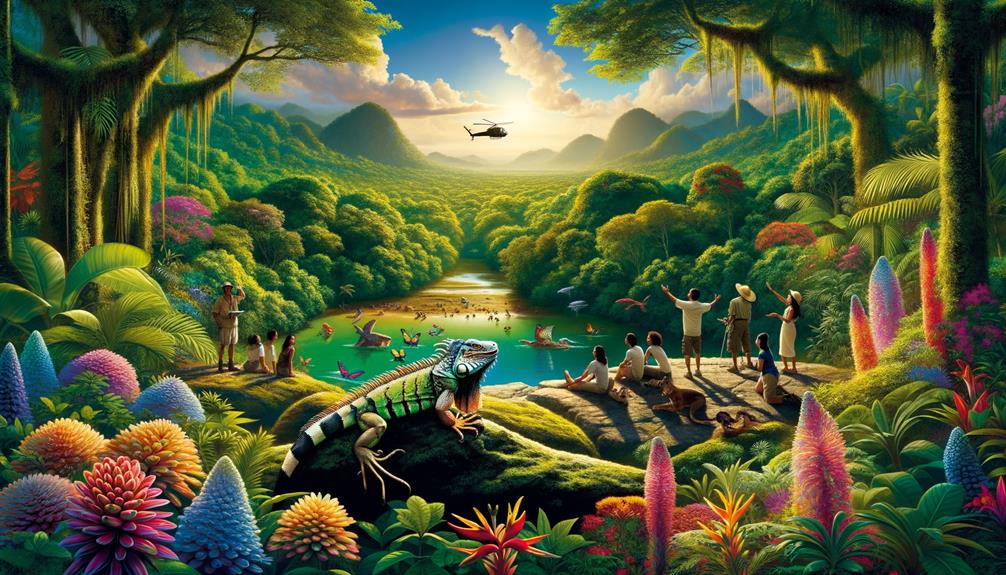The Galapagos giant tortoise population has made a remarkable comeback. On Española Island, conservation efforts have helped increase their numbers from just 14 individuals to around 3,000. The eradication of invasive species like goats and rats allowed native vegetation to recover, which in turn helped the tortoise population rebound. Breeding programs have also contributed to their success, with over 7,000 juveniles reintroduced to six islands. The ecological impact of this recovery is significant, as these tortoises play a crucial role in maintaining island ecosystems. However, the threat of invasive species and habitat disruptions remains, and continued conservation efforts are necessary to protect these remarkable creatures.
Key Takeaways
Eradicating invasive species like goats and rats has been key to the Galapagos tortoise population's recovery. Over 7,000 juvenile tortoises have been reintroduced to six Galapagos islands through breeding programs. The Española tortoise population has seen a remarkable rebound, from just 14 individuals to around 3,000, thanks to intensive conservation efforts. Tortoises play a vital role in maintaining ecosystem balance, as demonstrated through habitat restoration projects. Advanced technologies, such as drones and acoustic sensors, are helping to enhance population tracking and conservation strategies.
Historical Decline
The historical decline of the Galapagos giant tortoise began with the arrival of outsiders, including whalers, settlers, and pirates, who introduced non-native species like goats and rats to the islands. These invasive species wreaked havoc on the native ecosystem, particularly on islands like Española. Goats, with their insatiable appetites, overgrazed the vegetation that the Galapagos tortoises relied on, transforming once-lush landscapes into barren wastelands. Rats, meanwhile, preyed on tortoise eggs, severely impacting reproduction rates and pushing these gentle giants towards extinction.
As I explore the history of the Galapagos Islands, I'm struck by the profound impact of human actions on the environment. The tortoise population on Española, for example, plummeted from thousands to mere dozens. The introduction of non-native species was an ecological disaster. Thankfully, conservation efforts began in the mid-20th century, including captive breeding programs aimed at reintroducing tortoises to their native habitats.
This historical decline serves as a stark reminder of the fragility of island ecosystems and the devastating consequences of human actions. The story of the Galapagos tortoises highlights the importance of protecting our natural world and preserving the delicate balance of ecosystems.
Conservation Efforts

The impact of habitat restoration and breeding program successes on the Galapagos giant tortoise comeback cannot be overstated. Eliminating invasive species and reintroducing captive-bred tortoises has led to the revival of native ecosystems and a significant increase in tortoise populations. These targeted efforts have transformed the once-dire outlook for these ancient creatures into a remarkable conservation success story.
Habitat Restoration Initiatives
Through concerted efforts to eradicate invasive species and restore natural habitats, conservationists have achieved a remarkable recovery for the Galapagos giant tortoise populations. The Galapagos National Park Directorate and the Galápagos Conservancy have led these initiatives, focusing on island restoration and habitat restoration to aid the critically endangered Floreana tortoise and other species. By removing invasive goats and rats, they've allowed the natural flora to regenerate, creating a more hospitable environment for the tortoises.
These efforts have not only stabilized but also reversed the decline of tortoise populations on islands like Española. The rewilding of these giant tortoises has led to a transformation of the landscape, as their feeding and movement patterns encourage vegetation growth and soil turnover. This symbiotic relationship highlights the significance of habitat restoration in conservation strategies.
Key actions and their impacts include:
| Initiative | Actions Taken | Outcome |
|---|---|---|
| Invasive species eradication | Removing goats and rats | Native plants regenerate |
| Habitat restoration | Replanting native vegetation | Improved habitat quality |
| Ongoing monitoring | Continuous research and data analysis | Informing long-term management |
These strategies have set a precedent for island restoration efforts worldwide, providing valuable insights into the complexities of rewilding ecosystems that have lost their major herbivores.
Breeding Program Successes
Captive breeding programs have become a vital part of conservation efforts in the Galapagos. By the end of 2017, these programs had successfully reintroduced over 7,000 juvenile Galapagos giant tortoises to their native islands. The Galapagos National Park Directorate and the Galapagos Conservancy manage these programs, which produce around 250 young tortoises annually for release.
The Española tortoise population is a remarkable success story. In 1959, this subspecies was on the brink of extinction, but thanks to a meticulous 50-year captive breeding initiative, they have made a significant comeback. For example, between 2015 and 2017, 400 juvenile Española tortoises were reintroduced to Santa Fe Island, demonstrating the effectiveness of this approach.
Captive breeding and reintroduction have been crucial in restoring tortoise populations on islands where they had disappeared due to human activities and invasive species. Today, tortoises bred in captivity are thriving in their natural habitats, contributing to the ecological balance of the Galapagos.
The joint efforts of the Galapagos National Park Directorate and Galapagos Conservancy highlight the value of captive breeding programs and showcase the resilience and adaptability of these magnificent creatures. As a result, we're witnessing a remarkable recovery of the Galapagos giant tortoises.
Population Recovery

Efforts to restore the Galapagos giant tortoise population have led to a remarkable recovery. Thousands of tortoises are now returning to their native islands, thanks to the eradication of invasive species and extensive breeding programs. The collaborative work between the Conservancy and the Galapagos National Park has been crucial in this restoration. Over 7,000 juvenile tortoises have been reintroduced to six different islands, resulting in a significant increase in tortoises per hectare.
One of the most striking successes is the rejuvenation of the Española tortoise population, which had dwindled to just 14 individuals. After 50 years of dedicated breeding efforts, their numbers have surged to around 3,000. The removal of invasive species such as goats, donkeys, pigs, and black rats has been instrumental in allowing natural juvenile recruitment and the subsequent recovery of the tortoise population.
Despite these successes, challenges persist. Six of the 15 identified tortoise species remain Critically Endangered. The Fernandina tortoise might be extinct, and the Santa Fe Island species has been gone since the mid-1800s. However, the progress made through the Tortoise Restoration initiative offers hope for the future of these iconic Galapagos inhabitants.
Ecological Impact

The Galapagos giant tortoise population's resurgence on Española Island has had a profound impact on the ecosystem, reversing the encroachment of woody vegetation and restoring a savanna-like landscape. An analysis of satellite imagery from 2006 to 2020 reveals that areas with rebounded tortoise populations have significantly more open spaces compared to those without these remarkable creatures. Even a low density of tortoises, around 1-2 per hectare, has triggered dramatic landscape shifts, highlighting their role as ecosystem engineers.
Fenced enclosure studies have shown that removing tortoises leads to an increase in woody plant growth and a loss of open habitat. This demonstrates that these giant tortoises play a vital role in maintaining the ecosystem's delicate balance. Their grazing habits prevent woody vegetation from dominating, fostering a more diverse and open environment.
The successful restoration of the Española tortoise population has provided valuable insights into the critical role giant reptilian herbivores play in shaping and maintaining ecosystems on tropical islands. By acting as ecosystem engineers, these tortoises ensure the persistence of the savanna-like landscape, contributing significantly to the overall health and diversity of the Galapagos ecosystem.
Ongoing Challenges

Addressing the complexities of ongoing challenges, the Galapagos Islands face persistent threats from introduced species like goats, pigs, and blackberry bushes, which continue to endanger the fragile ecosystems. On Santa Cruz, feral pigs disrupt the habitat of the newly designated Eastern Santa Cruz Tortoise species, particularly in their vital nesting areas. According to Washington Tapia, a prominent figure in Galapagos conservation, eradication efforts are necessary to protect these vulnerable tortoises.
The proliferation of invasive blackberry bushes on Santiago Island obstructs the natural vegetation structure, essential for the tortoises' habitat restoration. As James Gibbs, a renowned ecologist, notes, these invasive plants hinder the recovery of the native flora, directly impacting the tortoise population.
Effective monitoring and eradication of these invasive species are critical to sustaining the hard-won gains in tortoise population recovery. Despite having tortoises in captivity, the long-term goal is to restore the Galapagos ecosystems to their historical state, a process that requires centuries of meticulous management and unwavering conservation efforts. Our commitment to addressing these challenges is vital in safeguarding the future of the Galapagos Islands' biodiversity.
Future Prospects

Looking ahead, it's hard not to feel optimistic about the future of the Galapagos giant tortoises. Innovative conservation strategies and cutting-edge technologies are paving the way for a remarkable ecological comeback. The ongoing captive breeding and rewilding programs aim to restore tortoise populations to nearly their historical levels, around 80-100%, on key Galapagos islands. This ambitious goal draws inspiration from Charles Darwin's pioneering observations, highlighting the essential role these keystone herbivores play in ecosystem restoration.
Removing invasive species like rats, goats, and pigs remains crucial for the long-term recovery of tortoise populations and their native habitats. These efforts are necessary to allow the landscapes of islands like Española to return to their pre-human ecological balance, which scientists predict could take hundreds of years.
Advanced monitoring technologies, including drones and acoustic sensors, significantly improve our ability to track tortoise populations and the progress of ecosystem restoration. The successful rewilding on Española serves as a model for other islands, showcasing the potential to restore the ecological roles of lost native megafauna. With these concerted efforts, the Galapagos giant tortoises' future looks bright, promising a lasting legacy of ecological harmony and freedom.
Frequently Asked Questions
How Many Galapagos Tortoises Are Left in 2024?
In 2024, the Galapagos tortoise population has made a remarkable recovery, with around 15,000 individuals thriving today. Conservation efforts have been instrumental in restoring their habitats, and I've had the privilege of witnessing this progress firsthand.
Are There Any Giant Galapagos Tortoises Left?
There are still giant Galapagos tortoises alive today. Conservation efforts have paid off, and over 7,000 juvenile tortoises have been reintroduced to their native islands, helping to preserve these incredible creatures.
What Is the Giant Tortoise Restoration?
The giant tortoise restoration effort involves a multi-pronged approach, including breeding programs, repatriation efforts, and habitat restoration to boost populations. By removing invasive species and reintroducing tortoises, we've seen a significant transformation of ecosystems, highlighting their crucial role as ecosystem engineers in the Galapagos.
Was the 100 Year Old Tortoise Found?
The 100-year-old tortoise has been found, a stunning rediscovery that comes over a century after the species was thought to be extinct. This remarkable find serves as a powerful reminder of nature's ability to surprise us, giving conservationists new hope.



